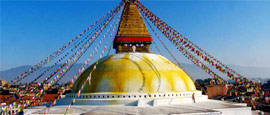Travel to Kathmandu
Flying to Kathmandu
Airlines offering flights to Kathmandu include Qatar Airways, Etihad, Turkish Airlines, Thai Airways, Silk Air, Jet Airways, Air India, and national carrier Nepal Airlines. Most routes from Europe connect through India or the Persian Gulf. Note that Nepali airlines have a poor safety record, particularly for domestic flights.
There can be a lot of demand for seats in the peak trekking season from October to November and February to April, particularly on the busy route between Delhi and Kathmandu. If you go trekking, allow a few days between the end of your trek and your flight home in case of delays flying back to Kathmandu from the trailheads.
All of Nepal’s airports are operating as normal after the earthquakes, but several airlines have altered their routes because of fuel shortages in Nepal, with additional stops en route to or from Nepal. Prices for domestic flights have also increased significantly because of the fuel shortages.
From London - 13 hours; New York - 21 hours; Los Angeles - 21 hours; Toronto - 21 hours; Sydney - 14 hours.
Website:www.tiairport.com.np
Location:
Kathmandu Tribhuvan International Airport is located 5km (3 miles) east of Kathmandu.
Money:
There is one currency exchange counter in the departure lounge and two in the arrivals lounge. Several ATMs are located throughout the airport.
Luggage:
There are numerous individuals around the airport who will offer to carry luggage (for a fee). Trolley services are available throughout both terminals and the baggage help desk located in the arrivals area provides information for passengers about their luggage. Any lost baggage can also be reported to the baggage help desk.
Travel by road
Nepal is connected by road to India and Tibet in China but few people attempt to enter Nepal with their own vehicles. Travelling by road in Nepal is a chaotic experience; few locals obey traffic rules and most drivers prefer to use the horn rather than the brakes.
Self-drive car hire is non-existent, but it’s easy to hire a car and driver for longer road trips. Motorcycles are available for hire in Kathmandu, but you will only be covered by insurance if you possess an international driving permit or a drivers’ license from your home country endorsed for motorcycles.
Officially, the minimum driving age is 18, and traffic drives on the left, but in practice vehicles use whichever piece of tarmac is in the best state of repair. Drinking and driving is prohibited but the rules are laxly enforced, adding to the danger on Nepal’s roads.
The speed limit tends to be whatever vehicles are capable of, and considering the condition of the brakes on local vehicles, slow, cautious driving is strongly advised. Note that bribes are often requested at police roadblocks, from locals as well as foreign drivers.
Fuel shortages can also play havoc with road transport in Nepal. When supplies are low, fuel may be rationed and may be unavailable for days at a time. Nepal depends on India for its fuel supplies and a diplomatic dispute between the two countries in 2015 saw deliveries reduced to a trickle.
There are no emergency breakdown companies in Nepal, so you’ll have to rely on the local mechanics found in every town.
There are two roads linking Kathmandu with the rest of Nepal. The main route to the Terai is via the Prithvi Highway to Pokhara, which connects with the main highway south to the plains at Mugling. For a scenic alternative, the Tribhuvan Highway follows a winding route down from the hills via Daman, connecting through to Birgunj on the Indian border.
Heading north, the Arniko/Friendship Highway runs to the Tibetan border post at Kodari. This is the main route connecting Nepal and Tibet but the road was severely damaged by the 2015 earthquakes, and some sections are still under repair. All roads in the hills are vulnerable to landslides, and there is a high risk of further slides following the tremors.
From Pokhara - 6 hours; Chitwan National Park - 6 hours; Kodari (Tibetan border) - 4 hours; Birgunj - 5 hours; Sonauli - 8 hours.
Long-distance bus services operate from Gongbu bus station (tel: +977 1 435 3030), just off the Ring Road in the north of Kathmandu. A number of private companies run comfortable air-conditioned 'tourist buses' from central Kathmandu to Pokhara, Lumbini and Chitwan National Park, but these are sometimes suspended during fuel shortages. Most buses leave early in the morning from Kantipath, close to the main turn-off into Thamel.
Reputable companies include Greenline (tel: +977 1 425 7544; www.greenline.com.np), Blue Sky Tours and Travel (tel: +977 985 6011 611; http://www.blueskytoursnepal.com) or Golden Travels (tel: +977 1 422 0036; www.goldentourandtravel.yolasite.com).
The Sajha Yatayat Bus Company (tel: +977 1 555 2686; www.sajhayatayat.com.np) ran buses from Kathmandu to Tibet until 2006, but services are unlikely to resume any time soon, partly because of earthquake damage to the roads linking Tibet and Nepal.
Currently, the only option for tourists is to join an organised tour from Kathmandu to Lhasa, crossing the border by jeep at Kodari and flying back from Lhasa. However, this depends on the road being open, and earthquake damage is still being repaired on many sections of the Arniko/Friendship Highway.
Travel by rail
There are no railway services to Kathmandu.
Do you have any Feedback about this page?
© 2025 Columbus Travel Media Ltd. All rights reserved. No part of this site may be reproduced without our written permission, click here for information on Columbus Content Solutions.








 You know where
You know where